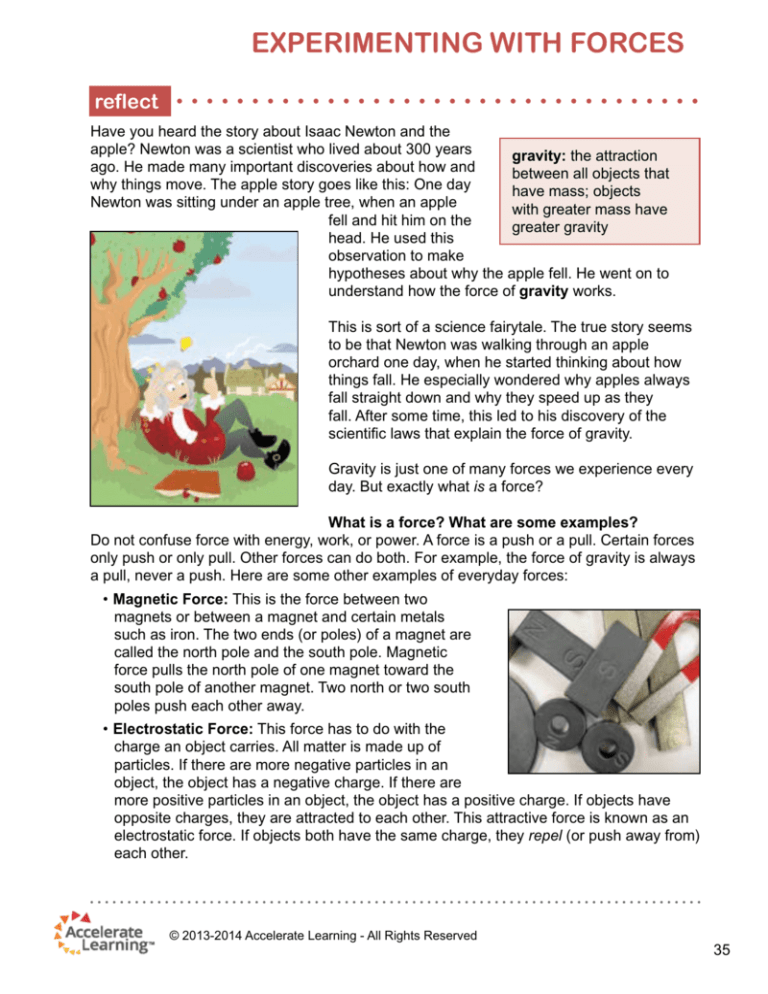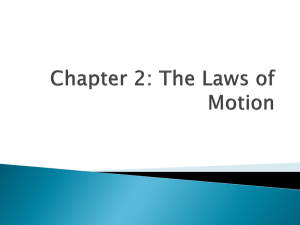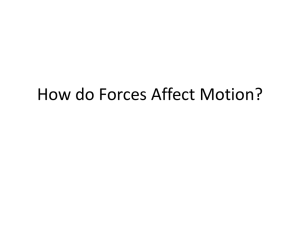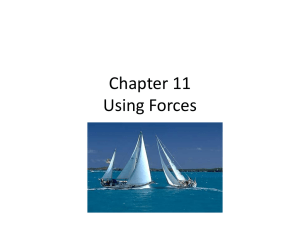
Experimenting With Forces
reflect
Have you heard the story about Isaac Newton and the
apple? Newton was a scientist who lived about 300 years
gravity: the attraction
ago. He made many important discoveries about how and
between all objects that
why things move. The apple story goes like this: One day
have mass; objects
Newton was sitting under an apple tree, when an apple
with greater mass have
fell and hit him on the
greater gravity
head. He used this
observation to make
hypotheses about why the apple fell. He went on to
understand how the force of gravity works.
This is sort of a science fairytale. The true story seems
to be that Newton was walking through an apple
orchard one day, when he started thinking about how
things fall. He especially wondered why apples always
fall straight down and why they speed up as they
fall. After some time, this led to his discovery of the
scientific laws that explain the force of gravity.
Gravity is just one of many forces we experience every
day. But exactly what is a force?
What is a force? What are some examples?
Do not confuse force with energy, work, or power. A force is a push or a pull. Certain forces
only push or only pull. Other forces can do both. For example, the force of gravity is always
a pull, never a push. Here are some other examples of everyday forces:
•Magnetic Force: This is the force between two
magnets or between a magnet and certain metals
such as iron. The two ends (or poles) of a magnet are
called the north pole and the south pole. Magnetic
force pulls the north pole of one magnet toward the
south pole of another magnet. Two north or two south
poles push each other away.
•Electrostatic Force: This force has to do with the
charge an object carries. All matter is made up of
particles. If there are more negative particles in an
object, the object has a negative charge. If there are
more positive particles in an object, the object has a positive charge. If objects have
opposite charges, they are attracted to each other. This attractive force is known as an
electrostatic force. If objects both have the same charge, they repel (or push away from)
each other.
© 2013-2014 Accelerate Learning - All Rights Reserved
35
Experimenting With Forces
•The Force of Friction: This is a force that slows things down. Have you noticed that
things that are rolling or sliding or otherwise in motion eventually slow down and stop?
If no other forces are involved, moving objects on Earth slow down because of friction.
The cause of friction is the rubbing together of two surfaces. The rougher the surfaces,
the greater the force of friction.
•Mechanical Force: Machines like cars can supply mechanical
forces. Animals and people can also supply mechanical
forces. In any case, a source of energy is necessary. Think
about walking or riding a bike. Mechanical forces can help you
move! The force of feet pushing on the pedals
of a bicycle, the force of a hammerhead on a
nail, and the force of a canoe paddle on water
are all examples of mechanical forces.
energy: the ability to
do work
•Spring Force: Some things change shape
when force is applied to them. A lump of
modeling clay and a balloon both change
shape when you squeeze them. However,
the modeling clay keeps the new shape it
was squeezed into. The balloon returns to
its original shape when the force is removed.
The force that returns the balloon to its
original shape is called spring force. Some
other things that can exert spring force are
rubber bands, fishing poles, and (of course)
springs.
what do you think?
How are gravitational, magnetic, and electrostatic forces different from mechanical,
frictional, and spring forces? (Here’s a hint: Which forces can act on objects at a distance—
that is, without touching?)
How can forces change an object’s movement, shape, or position?
Isaac Newton discovered more than just the laws of gravity. He also explained how force is
related to motion, or the movements of objects. Newton explained force and motion in three
simple laws.
•Newton’s first law: Things don’t change their motion unless a force acts on them. This
means that things that aren’t moving stay put, and things that are in motion keep on
moving at the same speed in a straight line.
36
© 2013-2014 Accelerate Learning - All Rights Reserved
Experimenting With Forces
look out!
You have probably noticed that moving objects always seem to slow down and stop. Many
people would say that this is because the force that set the object in motion has worn off.
Other people would say that nothing moves unless a force is acting on it all the time. Both
are wrong!
Objects in motion stop because the force of friction acts on them. Friction acts in the
direction opposite to the direction of motion. Objects in motion have energy of motion,
which is called kinetic energy. Friction changes that energy of movement to heat energy.
When all the kinetic energy has been changed to heat energy, the object stops. Sometimes
you can feel the heat caused by friction. The warmth you feel when you rub your hands
together is caused by friction. Only when an object is moving through empty space will it
continue to move without slowing down. That is why Earth never stops circling around the
Sun. Earth doesn’t experience any friction because there are no particles in empty space!
•Newton’s second law: If a force continues to act on an object, it will move faster and
faster. This increasing speed is called acceleration. The greater the force, the greater
will be the acceleration. The greater the mass of the object,
the smaller will be the acceleration. A force can also cause
mass: the amount
a moving object to slow down. This is called negative
of “stuff” in an object
acceleration. Sound familiar? We just saw that friction
causes moving objects to have negative acceleration.
Discover science: What are meteors?
Meteors, which we sometimes call “shooting stars,” are bits of
rock flying through space that enter Earth’s atmosphere. We
see meteors because friction with the air causes them to burn
up. How is the flight of a meteor related to Newton’s first and
second laws? Think of a meteor, far from Earth, moving forward
at a constant speed. Space is very nearly empty,
so no friction or other forces are acting on the
meteor. This agrees with Newton’s first law.
When the meteor gets close to Earth, the pull of
Earth’s gravity causes it to accelerate. When it
enters the atmosphere, it slows down because
the force of friction is pushing in the other
direction. This process speeding up and slowing
down agrees with Newton’s second law.
atmosphere: the air
that surrounds Earth
•Newton’s third law: For every action there
is an equal and opposite reaction. This
means that forces always occur in pairs.
When a force acts on an object, the object
pushes back in the opposite direction with
the same amount of force.
© 2013-2014 Accelerate Learning - All Rights Reserved
37
Experimenting With Forces
In some cases, it is easy to see the third law in action. Your feet push down on the floor
with a force that is equal to your weight. The floor doesn’t move because it is pushing up
on the bottoms of your feet with an equal force. Picture two people facing each other while
standing on skateboards. They reach out and touch hands, and one person gives a push.
Both skateboards move backward even though only one person exerted a force. That is
because when one person exerted a force, he created an equal and opposite force, or
reaction.
How could you create an investigation to test the effect of force on matter?
We have already described an investigation you could carry out to study Newton’s third law
using two skateboards. Now we will see how we can investigate the first and second laws.
try now
All you need for this experiment is a board about two meters long; a chair; a smooth, flat
stone or small block of wood; and an ice cube.
1.Begin in a room with a carpeted floor. Prop one end of the board up on the chair and
rest the other end on the carpet. Make the slope steep enough so the stone will slide
down easily. Release the stone from the top of the slope, and measure how far it
slides across the floor.
2.Repeat the experiment in a room with a smooth floor (wood, linoleum, or tile). Keep
the slope the same, and release the stone from the same height. Measure how far
the stone slides across the floor.
3.Finally, release an ice cube from the same spot and measure how far it slides across
the smooth floor. (Be sure to clean up any water that melts.) Compare the distances
the objects slid in the three trials.
The only thing that changed in the three trials was the force of friction. In each case, the
friction acted in the direction opposite to the motion and caused negative acceleration.
Which type of floor caused the greatest force of friction? Which object caused the greatest
force of friction? By comparing friction and distance you should be able to conclude what
would happen if there were no forces acting on a sliding object. How does this experiment
agree with Newton’s first and second laws?
38
© 2013-2014 Accelerate Learning - All Rights Reserved
Experimenting With Forces
What do you know?
Sometimes arrows are used to show forces. The point of the arrow shows which way the
force is pushing, and the length of the arrow shows how strong the force is. The arrows
below show six different forces.
The long arrows are twice as long as the short arrows. This means the long arrows
represent forces twice as strong. Arrange the arrows around the two balls, below, so the
forces cause one ball to accelerate downward in a straight line and the other ball to stay
where it is without moving. Use each arrow once and only once, and use all arrows. Do not
change the directions or lengths of the arrows.
When you finish, arrange the arrows around the balls in other ways. How does each set of
forces affect the motion of the balls?
© 2013-2014 Accelerate Learning - All Rights Reserved
39
Experimenting With Forces
connecting with your child
Acceleration caused by the force of gravity
This experiment will demonstrate one aspect of Newton’s second law of motion.
For this investigation you will need the following:
•a stopwatch
•a ladder or a structure that allows you to drop an object
from a variety of heights
•a small, dense object that is easy to see, like a ball bearing
or golf ball
The procedure involves dropping the object from various
heights and measuring the time the object takes to fall. One
person will drop the object, and the other person will measure
the fall time with the stopwatch. Be careful to choose a place
where no one can be injured by the falling object.
Careful comparison of the times will illustrate that the constant
force of gravity exerted on the object causes it to accelerate.
If the falling speed were constant, doubling the height would
double the falling time; however, because the object is
accelerating, the falling time only increases by about 50%.
Some questions you may wish to discuss include:
•What if you had used a feather for the object you dropped?
How would the results be different? Why?
This falling
apple must be
accelerating
because the
pictures were
taken at equal time
intervals.
• One person jumps from an airplane and falls 30 meters
before opening the parachute. Another person travels
downward 30 meters in an elevator.
How is the motion of the two people different as they travel 30 meters?
How are the forces acting on the two people different?
How is what they feel different?
•Compare the motion of a ball thrown 10 meters into the air to the motion of a ball
dropped from 10 meters.
How is the motion of the two balls different as they travel 10 meters?
How are the forces acting on the two balls different?
40
© 2013-2014 Accelerate Learning - All Rights Reserved






